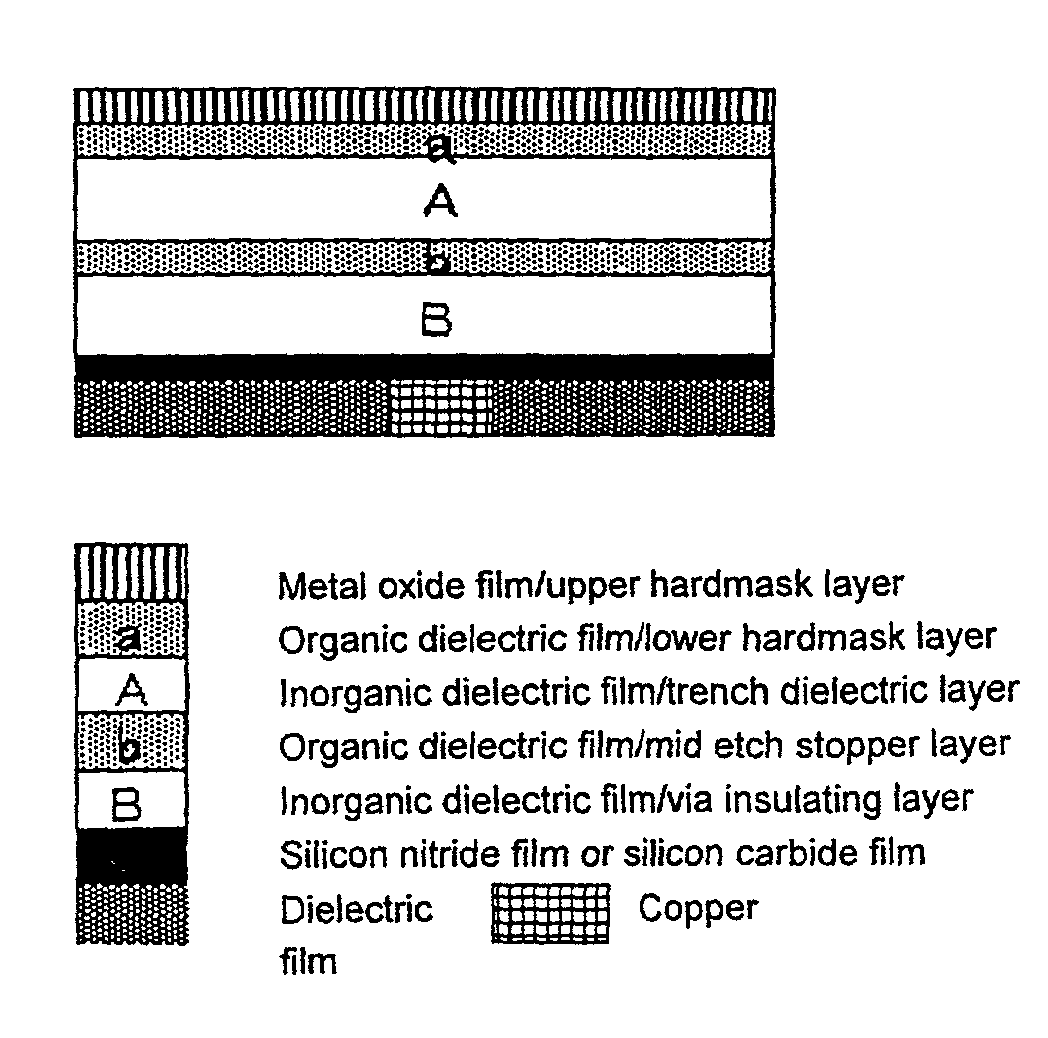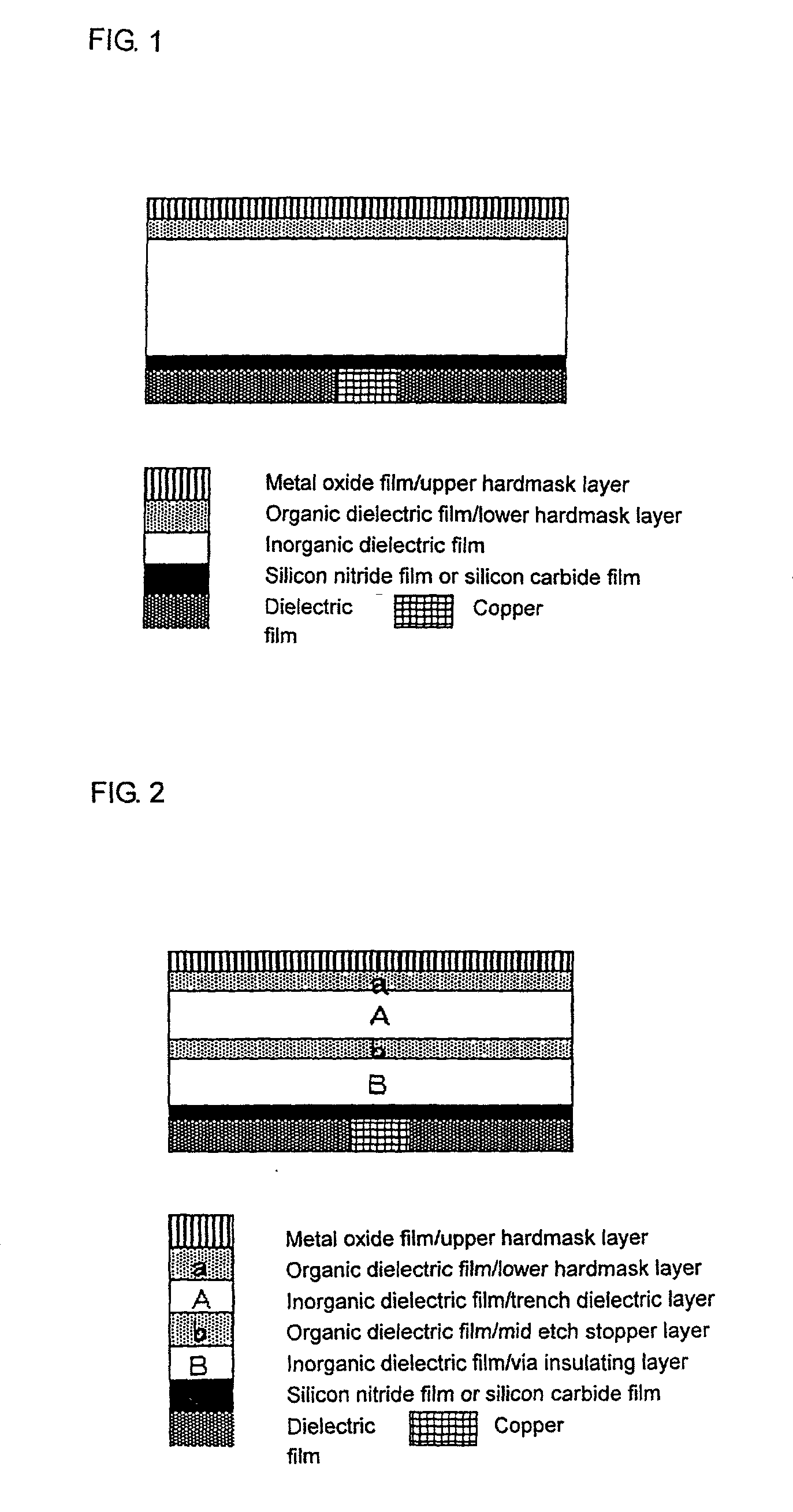Method of forming dual damascene structure
a damascene and structure technology, applied in the direction of semiconductor devices, semiconductor/solid-state device details, electrical equipment, etc., can solve the problems of low dielectric constant film damage, high production cost, and same problem
- Summary
- Abstract
- Description
- Claims
- Application Information
AI Technical Summary
Problems solved by technology
Method used
Image
Examples
synthesis example 2
[0118] Preparation of Coating Fluid for Organic Dielectric film
[0119] Into a flask were introduced 37.8 g of 9,9-bis(4-hydroxy-3-methylph-enyl)fluorene and 37.8 g of potassium carbonate together with 350 g of dimethylacetamide. The contents were heated at 150.degree. C. for 2 hours in a nitrogen atmosphere while removing the resulting water vapor from the system. To this solution was added 21.8 g of bis(4-fluorophenyl) ketone. The resulting mixture was reacted at 165.degree. C. for 10 hours, subsequently cooled, and then filtered to remove the insoluble matter contained in the solution. Reprecipitation was conducted from methanol. This precipitate was sufficiently washed with ion-exchanged water and then dissolved in cyclohexanone. After the insoluble matter was removed, the solution was poured into methanol to conduct reprecipitation. This precipitate was dried in a 60.degree. C. vacuum oven for 24 hours to obtain a polymer.
[0120] In 18 g of cyclohexanone was dissolved 2 g of the p...
synthesis example 3
[0121] Preparation of Coating Fluid for Metal Oxide Film Formation
[0122] (1) In 298 g of propylene glycol monopropyl ether was dissolved 106.4 g of tetramethoxysilane. This solution was stirred with a Three-One Motor to keep the solution temperature at 60.degree. C. Subsequently, 50 g of ion-exchanged water containing 2.1 g of maleic acid dissolved therein was added to the solution over 1 hour. Thereafter, the reaction mixture was reacted at 60.degree. C. for 4 hours and then cooled to room temperature. A solution containing methanol was removed in an amount of 90 g from the reaction mixture at 50.degree. C. by evaporation, and 643 g of propylene glycol monopropyl ether was added to the residue to obtain a solution (A).
[0123] (2) To the solution (A) was added 5 g of bis(4-t-butylphenyl)iodoni-um camphorsulfonate as ingredient (B). The resulting mixture was filtered through a Teflon filter having a pore diameter of 0.2 .mu.m to obtain a coating fluid for metal oxide film formation.
example 1
[0124] (1) A silicon nitride film having a thickness of 400 nm was formed on a silicon substrate by ordinary plasma CVD. The coating fluid for inorganic dielectric film formation prepared in Synthesis Example 1 was applied to the coated substrate by spin coating, and this substrate was heated first in the air at 80.degree. C. for 5 minutes and subsequently in nitrogen at 200.degree. C. for 5 minutes and then heated under vacuum at 425.degree. C. for 1 hour to thereby form a via insulating layer (A) composed of an inorganic dielectric film having a thickness of 300 nm.
[0125] The via insulating layer formed was subjected to a UV / ozone treatment to activate the surface thereof. Thereafter, the coating fluid for organic dielectric film formation prepared in Synthesis Example 2 was applied thereto by spin coating. This substrate was dried first at 80.degree. C. for 1 minute and subsequently at 200.degree. C. for 2 minutes and then further heated in a 450.degree. C. nitrogen atmosphere fo...
PUM
| Property | Measurement | Unit |
|---|---|---|
| dielectric constant | aaaaa | aaaaa |
| temperature | aaaaa | aaaaa |
| glass transition point | aaaaa | aaaaa |
Abstract
Description
Claims
Application Information
 Login to View More
Login to View More - R&D
- Intellectual Property
- Life Sciences
- Materials
- Tech Scout
- Unparalleled Data Quality
- Higher Quality Content
- 60% Fewer Hallucinations
Browse by: Latest US Patents, China's latest patents, Technical Efficacy Thesaurus, Application Domain, Technology Topic, Popular Technical Reports.
© 2025 PatSnap. All rights reserved.Legal|Privacy policy|Modern Slavery Act Transparency Statement|Sitemap|About US| Contact US: help@patsnap.com


